Deborah Silver is an accomplished and experienced landscape and garden designer whose firm first opened its doors in 1986.
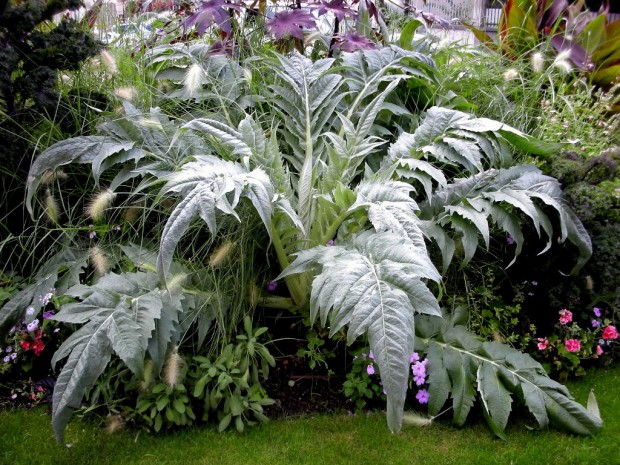 Cynara cardunculus, or cardoon, is also known as an artichoke thistle. It is a member of the sunflower family, and is native to Mediterranean climes. The giant coarse toothed leaves are architectural in form, and incredibly dramatic. A lot of that drama comes from the fact that those leaves are a very bright silvery gray. These silver leaves, in the right light, have a decidedly metallic cast. This amazing photograph of a cardoon is from www.greatplantpicks.org. Great Plant Picks is an educational program of the Elisabeth C. Miller Botanical Garden which debuted in 2001 with the first recommendations for a comprehensive palette of outstanding plants for the maritime Pacific Northwest. No wonder this cardoon has such a fascinating and an exotic look to me. I do not garden in the Mediterranean, or in the Pacific northwest.
Cynara cardunculus, or cardoon, is also known as an artichoke thistle. It is a member of the sunflower family, and is native to Mediterranean climes. The giant coarse toothed leaves are architectural in form, and incredibly dramatic. A lot of that drama comes from the fact that those leaves are a very bright silvery gray. These silver leaves, in the right light, have a decidedly metallic cast. This amazing photograph of a cardoon is from www.greatplantpicks.org. Great Plant Picks is an educational program of the Elisabeth C. Miller Botanical Garden which debuted in 2001 with the first recommendations for a comprehensive palette of outstanding plants for the maritime Pacific Northwest. No wonder this cardoon has such a fascinating and an exotic look to me. I do not garden in the Mediterranean, or in the Pacific northwest.
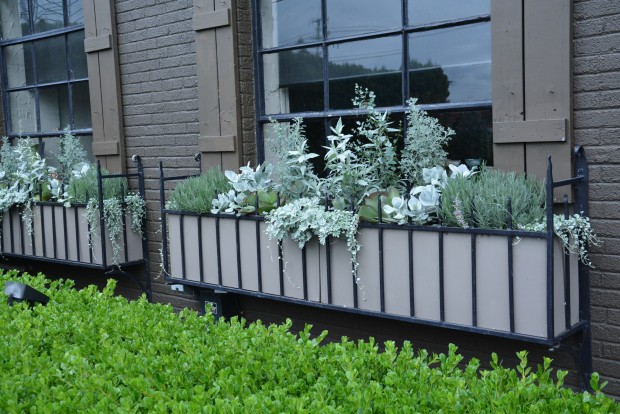 Silver leaved plants are not coated with some natural form of metallic silver. Many of them have leaves which are covered with very fine hairs that reflect light. That reflective quality makes the leaves appear silvery. According to the Plant Delights website, “The silver color is not a pigment, but rather some type of mechanism that scatters and reflects light. Some plants with silver foliage have a thick coat of foliar wax. Others are covered with fine hairs. A few silver perennials get their luster from blisters that separate the outer and inner cell layers of the leaf.” Silver leaved plants by and large hail from regions that are very hot and dry. That silvery surface is an adaptation – a means by which the plants can survive high heat and drought. Though I garden in a zone which gets regular rain, and infrequently has temperatures over 90 degrees, I love the look of silver leaved plants. This year’s window boxes at the shop-a celebration of silver leaves.
Silver leaved plants are not coated with some natural form of metallic silver. Many of them have leaves which are covered with very fine hairs that reflect light. That reflective quality makes the leaves appear silvery. According to the Plant Delights website, “The silver color is not a pigment, but rather some type of mechanism that scatters and reflects light. Some plants with silver foliage have a thick coat of foliar wax. Others are covered with fine hairs. A few silver perennials get their luster from blisters that separate the outer and inner cell layers of the leaf.” Silver leaved plants by and large hail from regions that are very hot and dry. That silvery surface is an adaptation – a means by which the plants can survive high heat and drought. Though I garden in a zone which gets regular rain, and infrequently has temperatures over 90 degrees, I love the look of silver leaved plants. This year’s window boxes at the shop-a celebration of silver leaves.
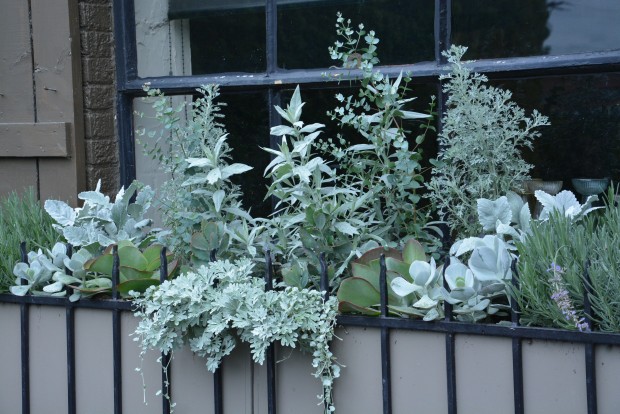 In the window boxes this year, I have planted artemesia “Valerie Finnis”, a blue/silver eucalyptus whose name I do not know, Cirrus dusty miller, a lavender with silver leaves, kalanchoe “Flapjacks”, the trailing artemesia “Silver Brocade”, an unknown silvery white succulent, and artemesia absinthium-or wormwood. I think I have identified these accurately, but maybe not. My knowledge of the names of exotic plants is sketchy. I was not shopping names for these window boxes. I was shopping color.
In the window boxes this year, I have planted artemesia “Valerie Finnis”, a blue/silver eucalyptus whose name I do not know, Cirrus dusty miller, a lavender with silver leaves, kalanchoe “Flapjacks”, the trailing artemesia “Silver Brocade”, an unknown silvery white succulent, and artemesia absinthium-or wormwood. I think I have identified these accurately, but maybe not. My knowledge of the names of exotic plants is sketchy. I was not shopping names for these window boxes. I was shopping color.
 Some of these plants might be hardy in my garden, provided they were planted in poor, gravelly, and fast draining soil. Others are strictly seasonal for me, as they would only survive the winter in a very mild climate. Some would thrive and return the following year, only given the absence of a winter.
Some of these plants might be hardy in my garden, provided they were planted in poor, gravelly, and fast draining soil. Others are strictly seasonal for me, as they would only survive the winter in a very mild climate. Some would thrive and return the following year, only given the absence of a winter.
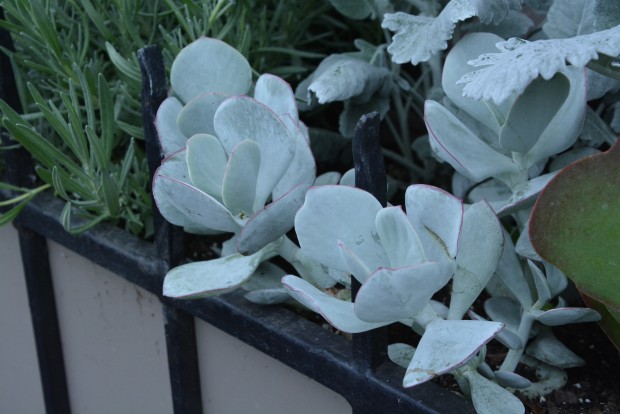 I am not generally drawn to succulent plants, only because they seem so out of place in a Michigan garden. But my container plantings can be comprised of any collection of plants that interest me. The best part of a seasonal/summer container planting is that I am not restricted by what would survive my winter. Most of the annual plants I use in containers come from tropical regions. I do use perennials hardy in Michigan in containers, provided their habit, texture, form and mass is such that they will look interesting all summer long. A columbine, or lupine in a pot has a very short season of interest. The coming of the hot weather – especially the hot nights – takes a toll on them. The tropical plants can handle the heat, should it come.
I am not generally drawn to succulent plants, only because they seem so out of place in a Michigan garden. But my container plantings can be comprised of any collection of plants that interest me. The best part of a seasonal/summer container planting is that I am not restricted by what would survive my winter. Most of the annual plants I use in containers come from tropical regions. I do use perennials hardy in Michigan in containers, provided their habit, texture, form and mass is such that they will look interesting all summer long. A columbine, or lupine in a pot has a very short season of interest. The coming of the hot weather – especially the hot nights – takes a toll on them. The tropical plants can handle the heat, should it come.
 As long as I have been gardening, much has been said about the hardiness of lavender. Early on, I planted no end of so called hardy lavender, without much success. My longest relationship with a lavender plant-4 years, and 3 winters. Hardiness is not exclusively dependent on winter temperatures. My area is known for its heavy clay soil. Lavender likes perfect drainage – light soil. Drainage is a surprisingly big part of winter hardiness. A new lavender from Peace Tree Farm shows a great deal of promise. From their website: “One of the hardiest lavenders seen throughout Europe and the United States, ‘Phenomenal’ has exceptional winter survival, as it does not have the winter die back that other varieties like Munstead and Hidcote commonly demonstrate. Lavender ‘Phenomenal’ has also shown tolerance to extreme heat and humidity, and is resistant to common root and foliar diseases. Most commonly popular for its silvery foliage and consistent growth with uniform, mounding habit, ‘Phenomenal’ has an elegant flower presentation and fragrance, perfect for fresh and dried arrangements and oil uses.” Hmm. I will have to buy some plants. What summer garden seems like a summer garden without lavender?
As long as I have been gardening, much has been said about the hardiness of lavender. Early on, I planted no end of so called hardy lavender, without much success. My longest relationship with a lavender plant-4 years, and 3 winters. Hardiness is not exclusively dependent on winter temperatures. My area is known for its heavy clay soil. Lavender likes perfect drainage – light soil. Drainage is a surprisingly big part of winter hardiness. A new lavender from Peace Tree Farm shows a great deal of promise. From their website: “One of the hardiest lavenders seen throughout Europe and the United States, ‘Phenomenal’ has exceptional winter survival, as it does not have the winter die back that other varieties like Munstead and Hidcote commonly demonstrate. Lavender ‘Phenomenal’ has also shown tolerance to extreme heat and humidity, and is resistant to common root and foliar diseases. Most commonly popular for its silvery foliage and consistent growth with uniform, mounding habit, ‘Phenomenal’ has an elegant flower presentation and fragrance, perfect for fresh and dried arrangements and oil uses.” Hmm. I will have to buy some plants. What summer garden seems like a summer garden without lavender?
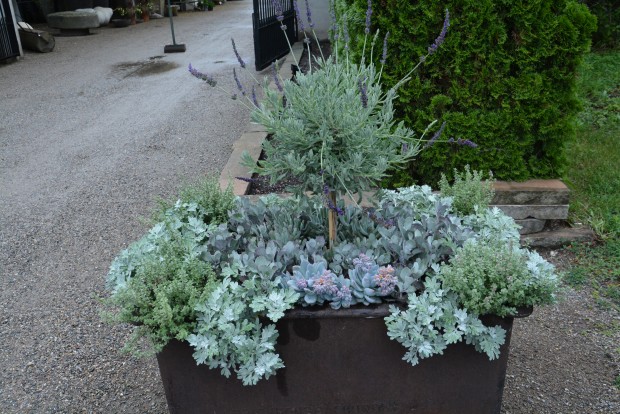 For the moment, I plant lavender in containers, never expecting I could plant them in the ground in the fall, and winter them over. This silver leaved plant is just as Mediterranean in its roots as the cardoons. I am happy to have them, one season. Lavender seems very happy, planted with other plants of like persuasion. The range of silvery colors from bright silvery gray to silvery blue gray in this iron cistern all seem visually compatible. I suspect all the plants enjoy the heat absorbed by the cistern.
For the moment, I plant lavender in containers, never expecting I could plant them in the ground in the fall, and winter them over. This silver leaved plant is just as Mediterranean in its roots as the cardoons. I am happy to have them, one season. Lavender seems very happy, planted with other plants of like persuasion. The range of silvery colors from bright silvery gray to silvery blue gray in this iron cistern all seem visually compatible. I suspect all the plants enjoy the heat absorbed by the cistern.
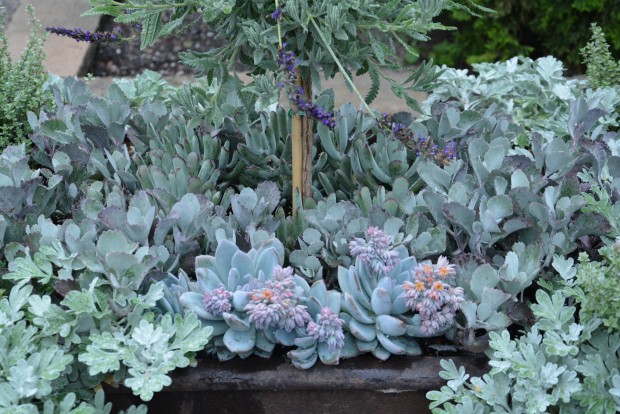 Proper watering will be key to their success. At Detroit Garden Works, we group all of the silvery leaved and succulent plants together on a table that is a do not water zone. Euphorbia “Diamond Frost” will deteriorate quickly from too much water. The leaves of helicrysum-licorice-will pucker and decline from too much water. Water the silver leaved plants as infrequently as possible, and then some. Your restraint will reward you.
Proper watering will be key to their success. At Detroit Garden Works, we group all of the silvery leaved and succulent plants together on a table that is a do not water zone. Euphorbia “Diamond Frost” will deteriorate quickly from too much water. The leaves of helicrysum-licorice-will pucker and decline from too much water. Water the silver leaved plants as infrequently as possible, and then some. Your restraint will reward you.
 Some of our echeverias only get water from the sky, when it comes. Otherwise, nothing, and certainly nothing from the hose. It may not have been the best year to decide to plant a collection of silver leaved plants. We have has lots of rain, dating back to early spring. Today, it rained all day, and it looks like it will continue to rain all night. My magnolias and parrotias have that lush green tropical look about them. The high temperature today-59 degrees. Not exactly Mediterranean.
Some of our echeverias only get water from the sky, when it comes. Otherwise, nothing, and certainly nothing from the hose. It may not have been the best year to decide to plant a collection of silver leaved plants. We have has lots of rain, dating back to early spring. Today, it rained all day, and it looks like it will continue to rain all night. My magnolias and parrotias have that lush green tropical look about them. The high temperature today-59 degrees. Not exactly Mediterranean.
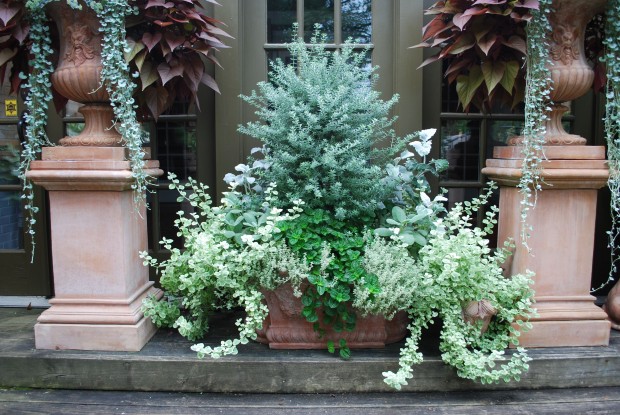 Silver, blue, and gray leaved plants are beautiful in containers. The teucrium fructicans, or silver bush germander, in the center of this container, was lovely all summer long. I wintered it over indoors successfully for 3 years.
Silver, blue, and gray leaved plants are beautiful in containers. The teucrium fructicans, or silver bush germander, in the center of this container, was lovely all summer long. I wintered it over indoors successfully for 3 years.
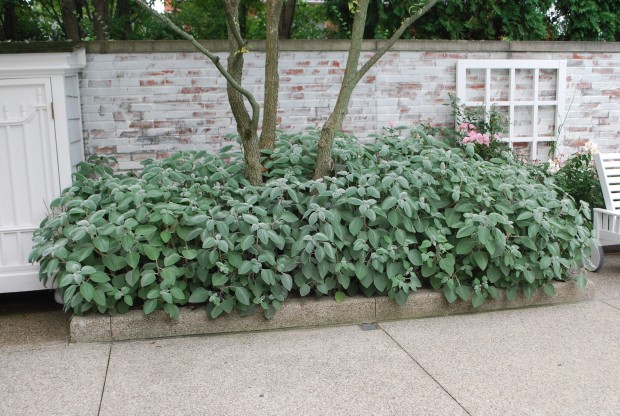 Plectranthus “Silver Shield” makes a beautiful seasonal groundcover. This small bed on a pool terrace is hot and dry in the extreme. I have never been able to get a perennial groundcover to winter over in this spot. The silvery gray is so beautiful with the pale pink roses, and white washed wall.
Plectranthus “Silver Shield” makes a beautiful seasonal groundcover. This small bed on a pool terrace is hot and dry in the extreme. I have never been able to get a perennial groundcover to winter over in this spot. The silvery gray is so beautiful with the pale pink roses, and white washed wall.
 Though the miscanthus grass in the center of this container is white, all of the silver leaves surrounding it makes those white leaves glow.
Though the miscanthus grass in the center of this container is white, all of the silver leaves surrounding it makes those white leaves glow.
 My most successful cardoon planting ever was in a tall container the top of which measured 14″ by 14″. Once it was established, it was happy to be hot and dry.
My most successful cardoon planting ever was in a tall container the top of which measured 14″ by 14″. Once it was established, it was happy to be hot and dry.
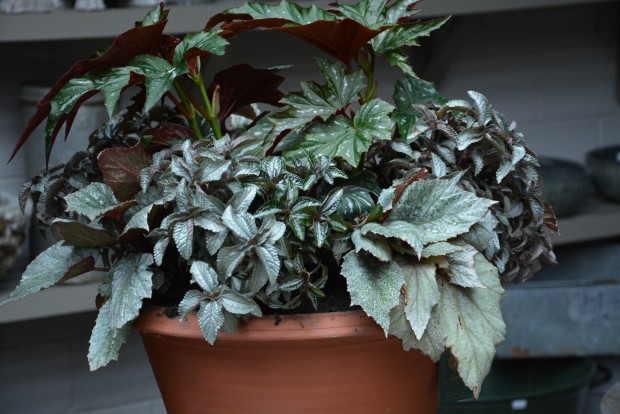 Some silver leaved plants do well in the shade. This silvery green begonia with silver blotches is underplanted with Shadow King gray begonia, and Pilea “Silver Tree”. Pilea “Silver Cloud” is equally as lovely. Silver leaved plants-I am happy to have access to them.
Some silver leaved plants do well in the shade. This silvery green begonia with silver blotches is underplanted with Shadow King gray begonia, and Pilea “Silver Tree”. Pilea “Silver Cloud” is equally as lovely. Silver leaved plants-I am happy to have access to them.
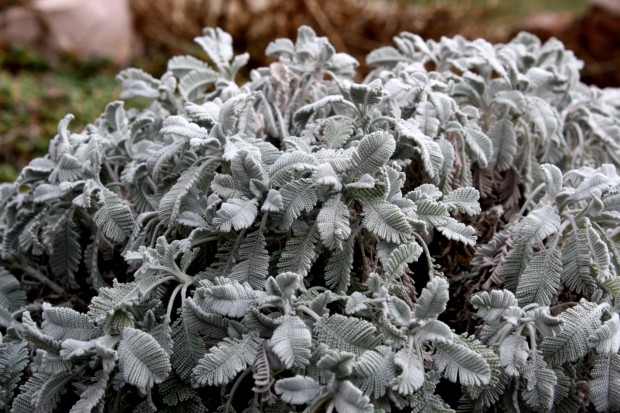 These are the silver gray leaves from a partridge feather plant. Have you ever?
These are the silver gray leaves from a partridge feather plant. Have you ever?
 I plant lots of seasonal containers for clients every year. This season has been particularly intense and compressed. Cold nights plagued our area until the very end of May. The week before Memorial Day, we had nights in the 30’s. I was wringing my hands at the prospect of getting out to plant so late, but I have always been stubborn about delaying the planting until we have three nights of 50 degrees or better in a row. It was beginning to feel like that day would never come. This year was a test that kept me awake at night. Even if the weather turns warmer by mid May, there is a terrific lot of work to do, in a short amount of time. So what does a compressed season have to do with the 6″ buckets of spikes pictured above? Rarely does the schedule of the planting of the summer containers permit leisurely planning. The weather turns. I have a lot of work to do. There are certain plants that look good to me, and others that do not interest me much. My design and plant choices boil down to instinct, experience, and whatever else captures my fancy. I have no choice but to trust my eye and my hand, and proceed without over thinking my decisions. As for spikes, I have no history of ever planting them in containers. This year I have planted a lot of them. Spikes. Yes, I have a little spike fest going on.
I plant lots of seasonal containers for clients every year. This season has been particularly intense and compressed. Cold nights plagued our area until the very end of May. The week before Memorial Day, we had nights in the 30’s. I was wringing my hands at the prospect of getting out to plant so late, but I have always been stubborn about delaying the planting until we have three nights of 50 degrees or better in a row. It was beginning to feel like that day would never come. This year was a test that kept me awake at night. Even if the weather turns warmer by mid May, there is a terrific lot of work to do, in a short amount of time. So what does a compressed season have to do with the 6″ buckets of spikes pictured above? Rarely does the schedule of the planting of the summer containers permit leisurely planning. The weather turns. I have a lot of work to do. There are certain plants that look good to me, and others that do not interest me much. My design and plant choices boil down to instinct, experience, and whatever else captures my fancy. I have no choice but to trust my eye and my hand, and proceed without over thinking my decisions. As for spikes, I have no history of ever planting them in containers. This year I have planted a lot of them. Spikes. Yes, I have a little spike fest going on.
 Who knows why I was suddenly so enamored of spikes. Maybe it is a result of having turned 65 a week ago. A murmuring dialogue about my age, and what that might mean may be influencing my choices. Maybe I was feeling old fashioned and out dated. Most years, I am compelled by a need, on some level, to explore. Exploring is generally a good thing. Though the fact that I was planting spikes in containers left and right alarmed me, I did not have the luxury of the time it would take to second guess the impulse. I rolled my eyes, and kept on planting them. Every gardener knows what spikes are. Their grandmother’s routine and pat pots of geraniums at the front door all has a spike in the middle. A pot full of geraniums with a spike in the middle-an icon of container planting from 50 years ago. Even the grandsons of the grandmothers who planted those spikes vaguely remember them, though they may not be able to identify any other seasonal plant. Today’s container plantings are endowed with an incredible variety of plants unknown and unavailable in 1950. Seasonal container design is a very exciting part of gardening right now. Every interested gardener has a generous palette of plants available, and a design atmosphere that is genuinely challenging and interesting.
Who knows why I was suddenly so enamored of spikes. Maybe it is a result of having turned 65 a week ago. A murmuring dialogue about my age, and what that might mean may be influencing my choices. Maybe I was feeling old fashioned and out dated. Most years, I am compelled by a need, on some level, to explore. Exploring is generally a good thing. Though the fact that I was planting spikes in containers left and right alarmed me, I did not have the luxury of the time it would take to second guess the impulse. I rolled my eyes, and kept on planting them. Every gardener knows what spikes are. Their grandmother’s routine and pat pots of geraniums at the front door all has a spike in the middle. A pot full of geraniums with a spike in the middle-an icon of container planting from 50 years ago. Even the grandsons of the grandmothers who planted those spikes vaguely remember them, though they may not be able to identify any other seasonal plant. Today’s container plantings are endowed with an incredible variety of plants unknown and unavailable in 1950. Seasonal container design is a very exciting part of gardening right now. Every interested gardener has a generous palette of plants available, and a design atmosphere that is genuinely challenging and interesting.
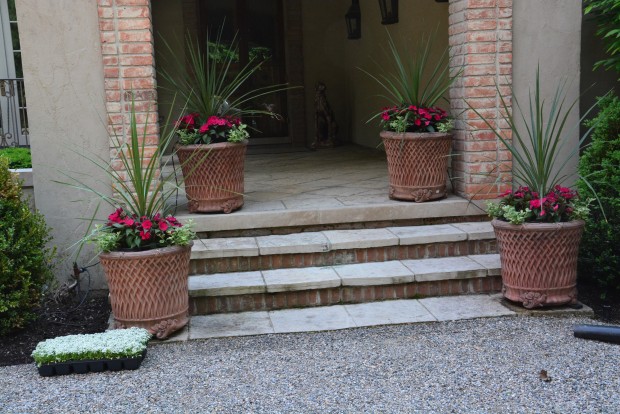 A spike, Dracaena indivisa, is a tropical green plant. It is easy to grow, and tolerates lots of different soil conditions. It likes regular water and sun, but will live amiably with less of everything that it wants. It can be moved inside over the winter, with a minimum of fuss. The timidly broad sword shaped leaves emanate from a central trunk. The leaves are lax, like a grass. They are the anti-centerpiece. They have no extraordinary color or texture. They are just about the last in line of the so called architectural plants available to plant in containers. They are plain green, as in invisibly green. Worse than that, they are very much out of fashion.
A spike, Dracaena indivisa, is a tropical green plant. It is easy to grow, and tolerates lots of different soil conditions. It likes regular water and sun, but will live amiably with less of everything that it wants. It can be moved inside over the winter, with a minimum of fuss. The timidly broad sword shaped leaves emanate from a central trunk. The leaves are lax, like a grass. They are the anti-centerpiece. They have no extraordinary color or texture. They are just about the last in line of the so called architectural plants available to plant in containers. They are plain green, as in invisibly green. Worse than that, they are very much out of fashion.
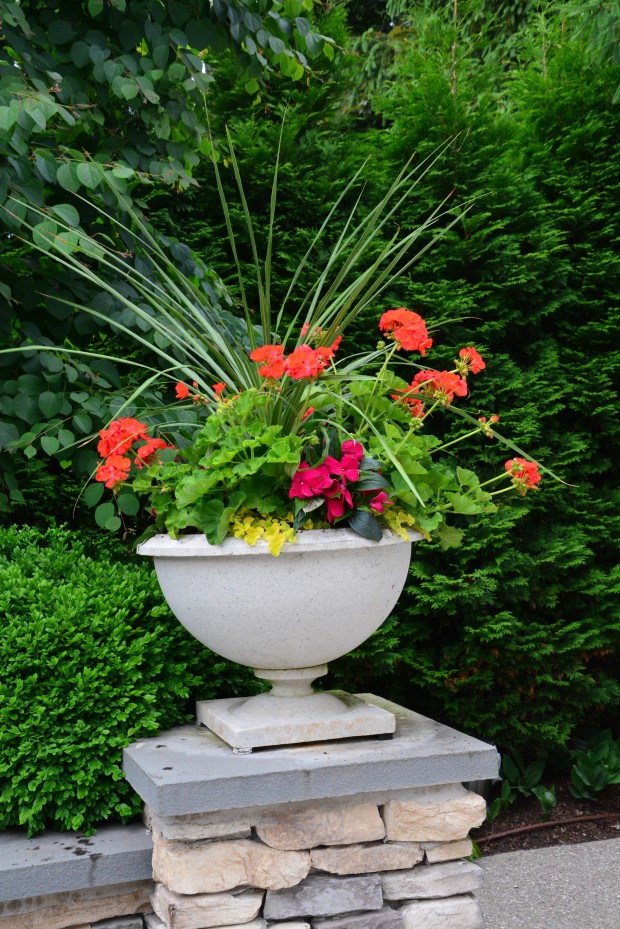 So what is it that I am liking about them? Giving up the notion that the center plant in a pot has to be the most important plant is key. I like how a spike gently and unobtrusively softens the appearance of all of these surrounding plants. The geraniums and New Guineas in this urn are stiff, unyielding, and visually demanding. The spike tones down all that bossy color and form.
So what is it that I am liking about them? Giving up the notion that the center plant in a pot has to be the most important plant is key. I like how a spike gently and unobtrusively softens the appearance of all of these surrounding plants. The geraniums and New Guineas in this urn are stiff, unyielding, and visually demanding. The spike tones down all that bossy color and form.
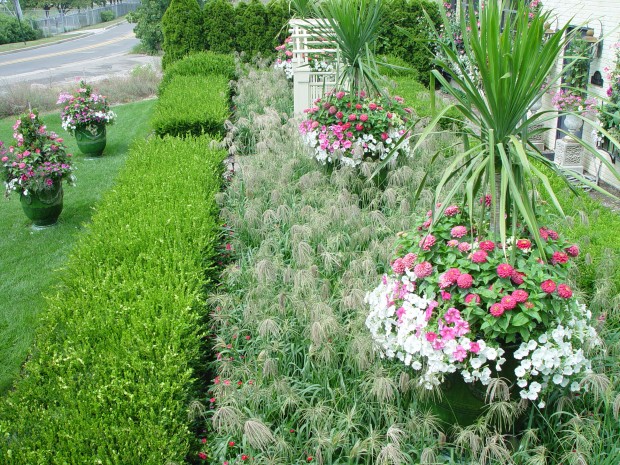 Spikes are simple to winter over in the house. Simple does not mean it is simple minded to plant them. I had this pair of spikes a number of years. Grown on to a large size, they have a much more architectural appearance. In this garden, they provided a little fireworks.
Spikes are simple to winter over in the house. Simple does not mean it is simple minded to plant them. I had this pair of spikes a number of years. Grown on to a large size, they have a much more architectural appearance. In this garden, they provided a little fireworks.
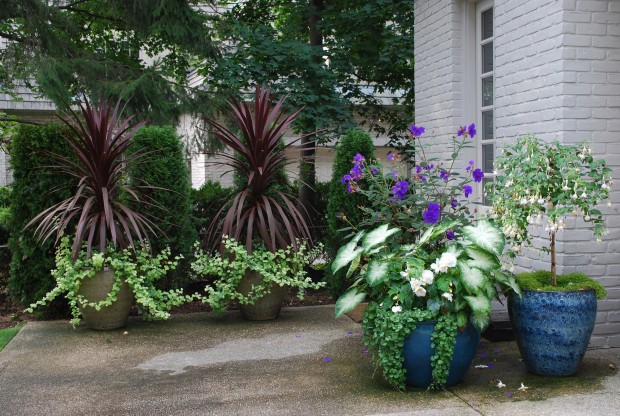 These old red cordylines were grown on from a 6 inch pot. Every year for 8 years now, the arrangement of the pots have changed based on the size of the plants.
These old red cordylines were grown on from a 6 inch pot. Every year for 8 years now, the arrangement of the pots have changed based on the size of the plants.
 Phormiums, commonly known as New Zealand flax, resemble spikes and cordyline in their habit, although the leaves are wider. Some phormiums are quite stiff leaved. Others are droopy. There are lots of cultivars available, in different colors and patterns. Phormiums will rot at the base, if they are planted too low in the container. Outside of that, they are as easy to grow as a spike.
Phormiums, commonly known as New Zealand flax, resemble spikes and cordyline in their habit, although the leaves are wider. Some phormiums are quite stiff leaved. Others are droopy. There are lots of cultivars available, in different colors and patterns. Phormiums will rot at the base, if they are planted too low in the container. Outside of that, they are as easy to grow as a spike.
 The color of this phormium picks up the predominate tones in this group of containers. That peachy pink is especially beautiful with the color of the terra cotta pots.
The color of this phormium picks up the predominate tones in this group of containers. That peachy pink is especially beautiful with the color of the terra cotta pots.
 This planting in this pool side pot is simple, but very strong visually. The phormium “Margaret Jones”, a group of vista fuchsia petunias, and some vinca maculatum work well together, and look nothing like the pots my grandmother planted.
This planting in this pool side pot is simple, but very strong visually. The phormium “Margaret Jones”, a group of vista fuchsia petunias, and some vinca maculatum work well together, and look nothing like the pots my grandmother planted.
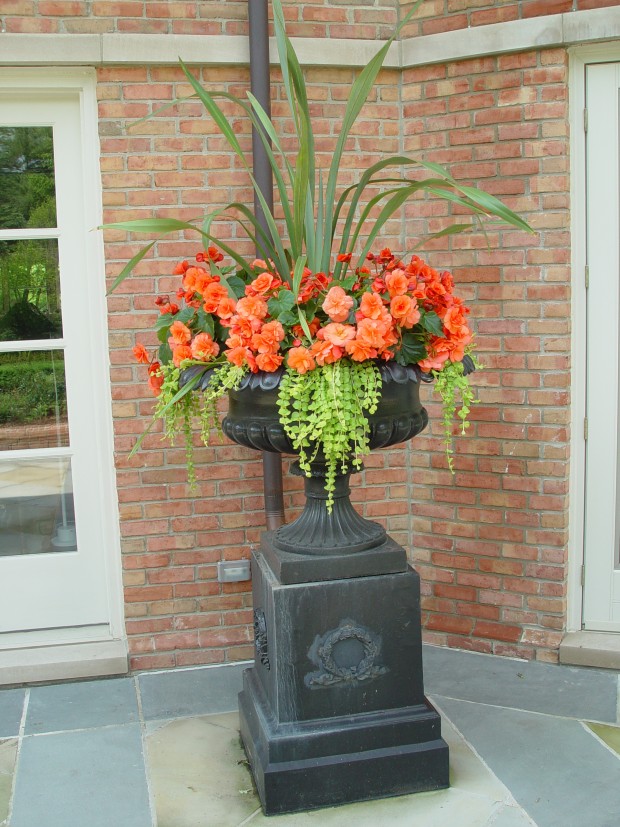 This green phormium is a lovely complement to the solenia begonias. Though it is centrally located in the composition, the visual focus is on the flowers.
This green phormium is a lovely complement to the solenia begonias. Though it is centrally located in the composition, the visual focus is on the flowers.
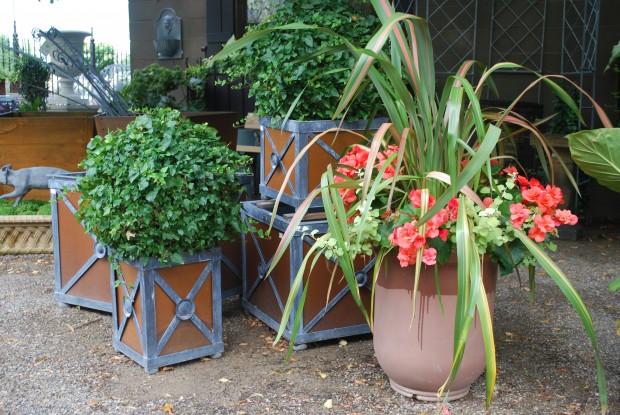 The phormium in this pot takes a much more active role in the overall feeling of this container. Informal and whimsical. The phormium is the plant equivalent of a casual and slightly messy hair do.
The phormium in this pot takes a much more active role in the overall feeling of this container. Informal and whimsical. The phormium is the plant equivalent of a casual and slightly messy hair do.
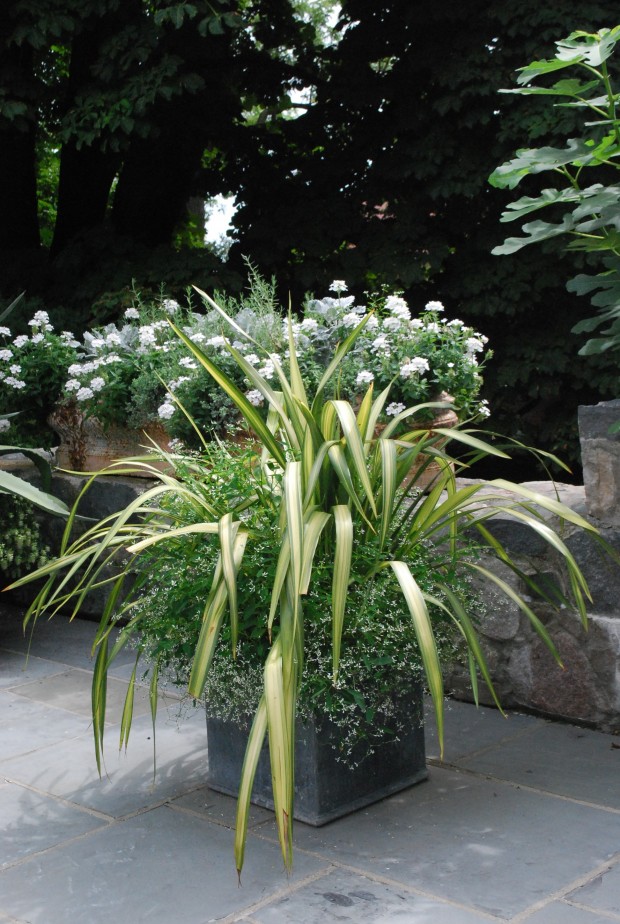 Phormium “Cream Delight” is hard to find, but it makes a beautiful statement in a container. The euphorbia diamond frost goes a long way towards softening that spiky appearance, and adds substance, not bulk.
Phormium “Cream Delight” is hard to find, but it makes a beautiful statement in a container. The euphorbia diamond frost goes a long way towards softening that spiky appearance, and adds substance, not bulk.
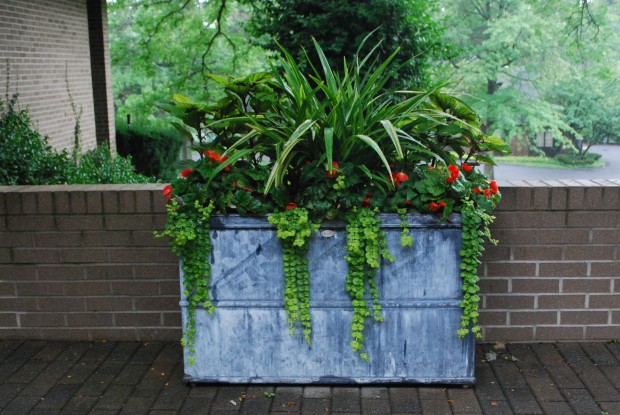 Last, but certainly not least, Dianella is related to phormiums, and similar in most ways except for overall size. They are great for smaller containers. I love how the leaves hover over the rest of the plants in this box. An added plus-dianella blooms.
Last, but certainly not least, Dianella is related to phormiums, and similar in most ways except for overall size. They are great for smaller containers. I love how the leaves hover over the rest of the plants in this box. An added plus-dianella blooms.
 I found a great selection of variegated cordylines at Tellys at Goldner Walsh yesterday. I have not decided what to put with this cultivar,”Torbay Dazzler”, but “Skies of Italy” fancy leaved geraniums might be lovely. This would be a spike and geranium combination that is both fresh and lively.
I found a great selection of variegated cordylines at Tellys at Goldner Walsh yesterday. I have not decided what to put with this cultivar,”Torbay Dazzler”, but “Skies of Italy” fancy leaved geraniums might be lovely. This would be a spike and geranium combination that is both fresh and lively.
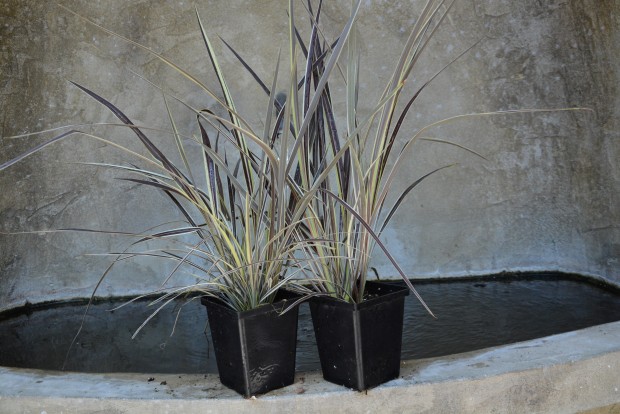 Cordyline “Electric Flash” is brown leaved with limey green stripes. Imagine the possibilities-all from a consideration of the spike.
Cordyline “Electric Flash” is brown leaved with limey green stripes. Imagine the possibilities-all from a consideration of the spike.
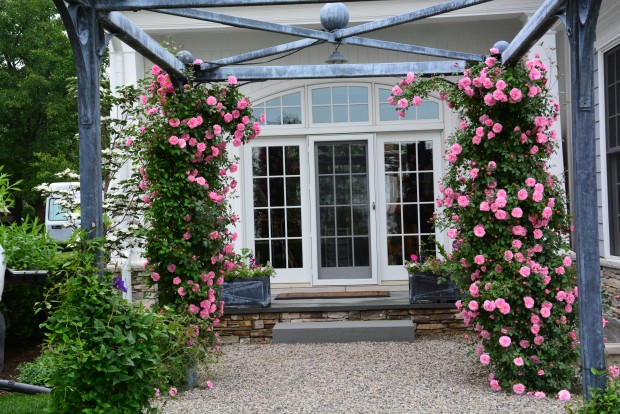 The very best part of doing containers for clients at the last of a landscape installation for a new house is the chance I might be able to to come back the following year. The opportunity to come back means I can watch, and be part of how that landscape settles in and prospers. The summer container planting comes around once a year, every year. In the best of all possible worlds, the process of the landscape design and installation results in a relationship that is on going. Planting seasonal containers is ongoing. I was happy to be invited back. The John Davis roses, which were part of the original landscape installation, are just about to the roof of the pergola, this June of year 3.
The very best part of doing containers for clients at the last of a landscape installation for a new house is the chance I might be able to to come back the following year. The opportunity to come back means I can watch, and be part of how that landscape settles in and prospers. The summer container planting comes around once a year, every year. In the best of all possible worlds, the process of the landscape design and installation results in a relationship that is on going. Planting seasonal containers is ongoing. I was happy to be invited back. The John Davis roses, which were part of the original landscape installation, are just about to the roof of the pergola, this June of year 3.
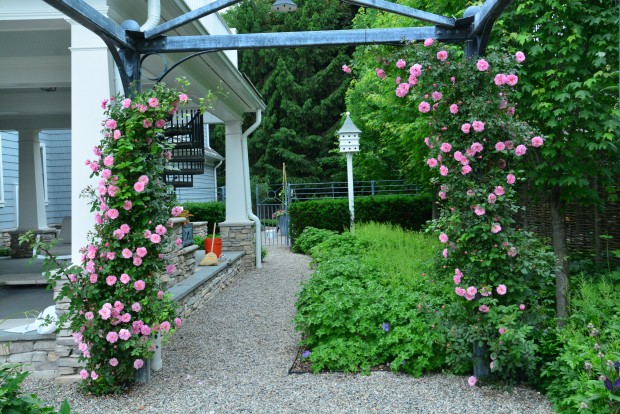 Any new landscape comes with troubles. What you thought would be perfectly happy in this spot refuses to perform. What seemed like a reach takes hold like you never imagined. Anyone who gardens knows trouble-and how that trouble can be difficult to foresee. This property fronts on a lake. The very heavy clay soil refuses to dry out. We had no end of troubles, getting this landscape to take hold. It is difficult, and takes time, to establish plants on a clay based soil. In the middle of year 2, a daunting year 2, we were making progress. Year two was not my favorite. It just had to be lived through. But once the plants take hold, they go for broke. Year 3 is looking good. Along this path to the side yard, each Rozanne geranium is the size of a small shrub. The astilbes are loaded with flower spikes. The yews have settled in, and are lush and dark green. And the roses-well, you can see for yourself.
Any new landscape comes with troubles. What you thought would be perfectly happy in this spot refuses to perform. What seemed like a reach takes hold like you never imagined. Anyone who gardens knows trouble-and how that trouble can be difficult to foresee. This property fronts on a lake. The very heavy clay soil refuses to dry out. We had no end of troubles, getting this landscape to take hold. It is difficult, and takes time, to establish plants on a clay based soil. In the middle of year 2, a daunting year 2, we were making progress. Year two was not my favorite. It just had to be lived through. But once the plants take hold, they go for broke. Year 3 is looking good. Along this path to the side yard, each Rozanne geranium is the size of a small shrub. The astilbes are loaded with flower spikes. The yews have settled in, and are lush and dark green. And the roses-well, you can see for yourself.
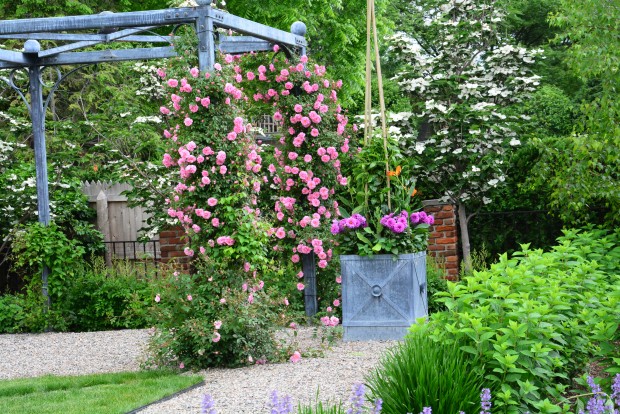 John Davis is a climbing rose which is incredibly vigorous and long lived. If pink flowers are to your liking, this rose will reward you with steady growth and lots of roses. I have a client withe John Davis roses that are better than 20 years old. It is undeniably hardy-bear in mind these roses on planted on the lake side, and subject to terrific winds and cold in the winter. Our last two winters were fiercely cold. I see damage to plants everywhere from those vicious winters. These roses never skipped a beat. Planting this summer annual container next to this John Davis in glorious bloom-what a treat.
John Davis is a climbing rose which is incredibly vigorous and long lived. If pink flowers are to your liking, this rose will reward you with steady growth and lots of roses. I have a client withe John Davis roses that are better than 20 years old. It is undeniably hardy-bear in mind these roses on planted on the lake side, and subject to terrific winds and cold in the winter. Our last two winters were fiercely cold. I see damage to plants everywhere from those vicious winters. These roses never skipped a beat. Planting this summer annual container next to this John Davis in glorious bloom-what a treat.
 This landscape has begun to come into its own. I did not know this, until the moment I got there with a truckload of flowers for the pots. The best part of spending the day here planting the containers here was the pure pleasure of experiencing a landscape and garden that has rooted in and has settled down. Everything is breathing, regularly. There is new growth on every plant, from the yews, to the Venus dogwoods, to the Himalayan white barked birch, to the hydrangeas-to the columnar red maples. The landscape is thriving. The heart of it is beating regularly, and strongly.
This landscape has begun to come into its own. I did not know this, until the moment I got there with a truckload of flowers for the pots. The best part of spending the day here planting the containers here was the pure pleasure of experiencing a landscape and garden that has rooted in and has settled down. Everything is breathing, regularly. There is new growth on every plant, from the yews, to the Venus dogwoods, to the Himalayan white barked birch, to the hydrangeas-to the columnar red maples. The landscape is thriving. The heart of it is beating regularly, and strongly.
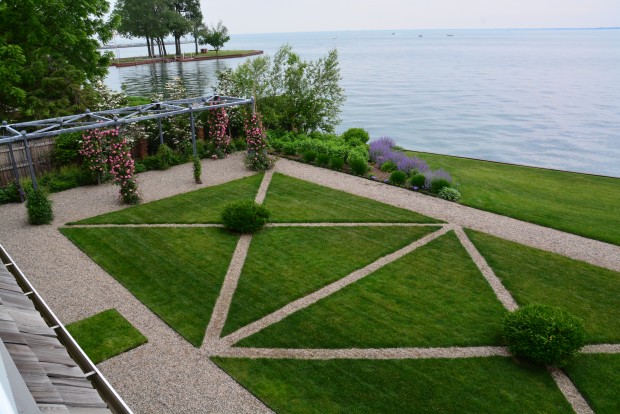 The boxwood dots in the lawn have put on a lot of weight. That dark green I see everywhere is a healthy green. How is my client managing a landscape on soil that does not drain? She manages, as she tends to the landscape. Her thoughtful work is obvious. The views from the second story deck was beautiful. That beauty is not of my doing, some three years after the original installation. It is hers. All a garden needs is for someone to take ownership, like she has.
The boxwood dots in the lawn have put on a lot of weight. That dark green I see everywhere is a healthy green. How is my client managing a landscape on soil that does not drain? She manages, as she tends to the landscape. Her thoughtful work is obvious. The views from the second story deck was beautiful. That beauty is not of my doing, some three years after the original installation. It is hers. All a garden needs is for someone to take ownership, like she has.
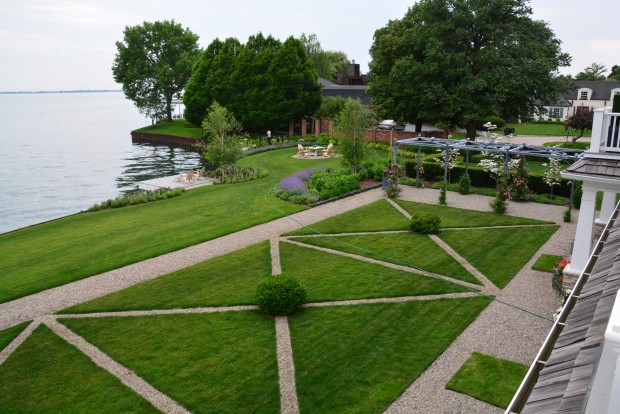 I did plant lots of containers for her today. She wanted orange geraniums, and nasturtiums. I planted them wherever I could. Next week I will plant her cutting flower boxes. We have had incredibly cold and rainy weather. I have postponed planting the zinnias and the sunflowers until next week.
I did plant lots of containers for her today. She wanted orange geraniums, and nasturtiums. I planted them wherever I could. Next week I will plant her cutting flower boxes. We have had incredibly cold and rainy weather. I have postponed planting the zinnias and the sunflowers until next week.
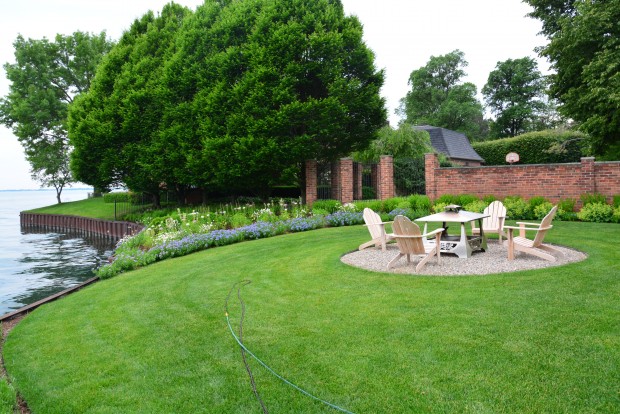 The wet meadow is loaded with amsonia Blue Ice-it is in bloom now. The shadier portions are planted with species monarda, and northern sea oats-Chasmanthium latifolium. The fact that it seeds is all to the good. That wet meadow will dry sometime soon. Cleome and sonata cosmos will provide color in this garden all the summer season long.
The wet meadow is loaded with amsonia Blue Ice-it is in bloom now. The shadier portions are planted with species monarda, and northern sea oats-Chasmanthium latifolium. The fact that it seeds is all to the good. That wet meadow will dry sometime soon. Cleome and sonata cosmos will provide color in this garden all the summer season long.
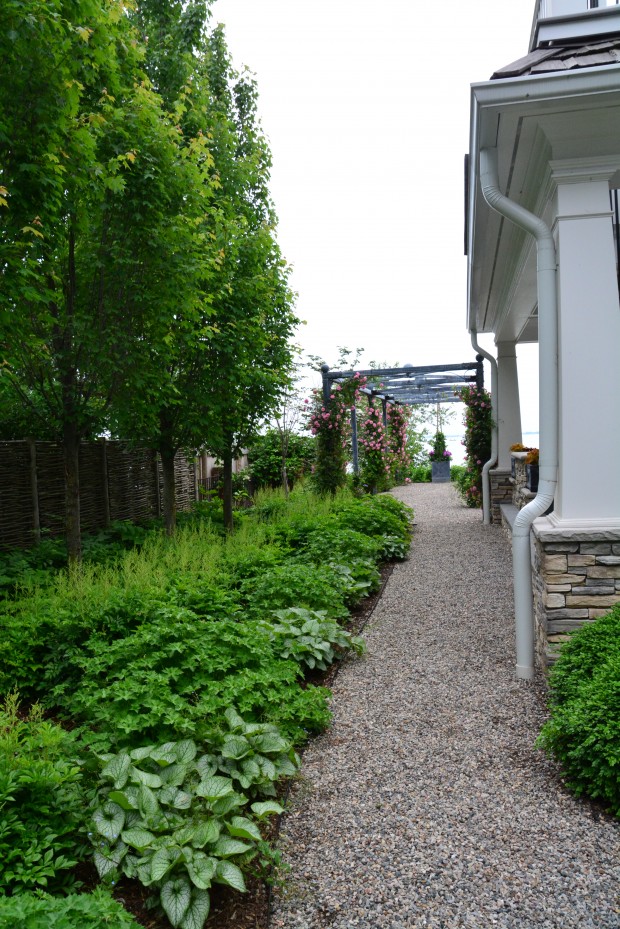 Though my trip here was to plant containers, how the landscape has taken hold has my attention. Plants in the right place is all the work of a garden-and all of the pleasure.
Though my trip here was to plant containers, how the landscape has taken hold has my attention. Plants in the right place is all the work of a garden-and all of the pleasure.
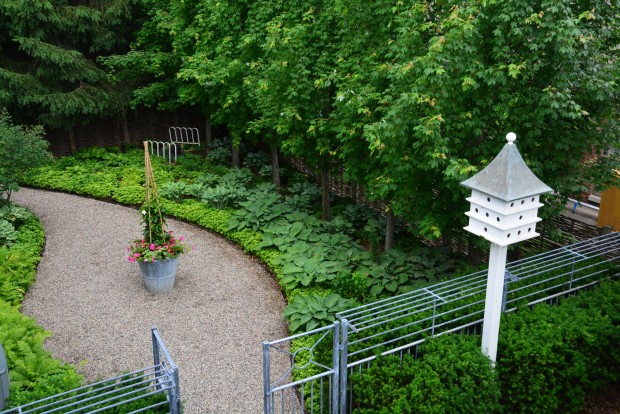 Willy’s garden is presided over by a big group of columnar red maples. Their foliage is lush this year – finally. The hostas are fanning out. In the front of the house, the peonies were full of blooms. The birch are growing. The katsura espaliers leafed out beyond all belief.
Willy’s garden is presided over by a big group of columnar red maples. Their foliage is lush this year – finally. The hostas are fanning out. In the front of the house, the peonies were full of blooms. The birch are growing. The katsura espaliers leafed out beyond all belief.
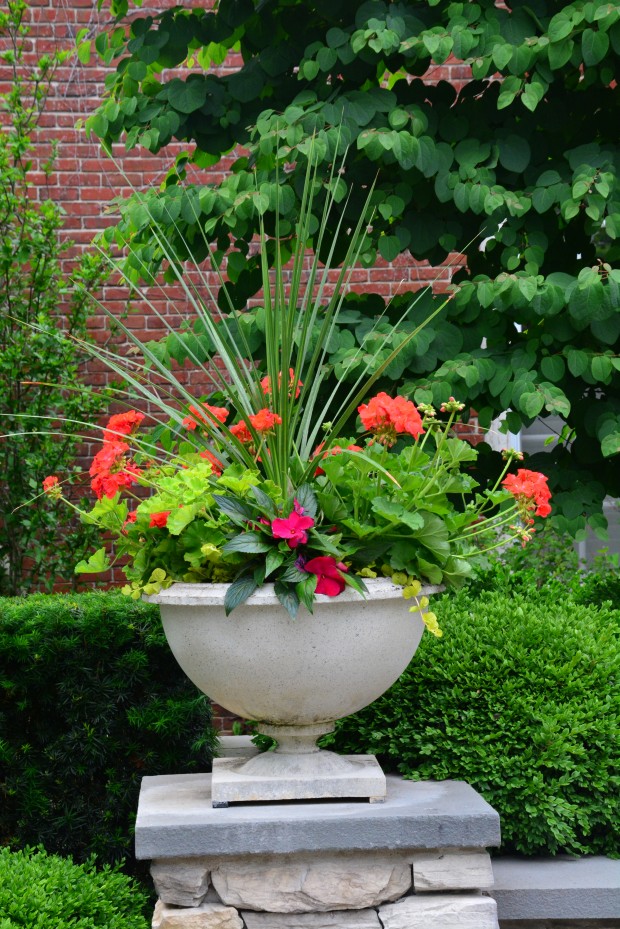 All of the containers featured orange in one form or another. I was pleased that this urn was stuffed with annual plants in a relaxed fashion. My crews do an amazing job of arranging all the plants that are scheduled to go into a container in a lively, lovely, and unpretentious way. From the start.
All of the containers featured orange in one form or another. I was pleased that this urn was stuffed with annual plants in a relaxed fashion. My crews do an amazing job of arranging all the plants that are scheduled to go into a container in a lively, lovely, and unpretentious way. From the start.
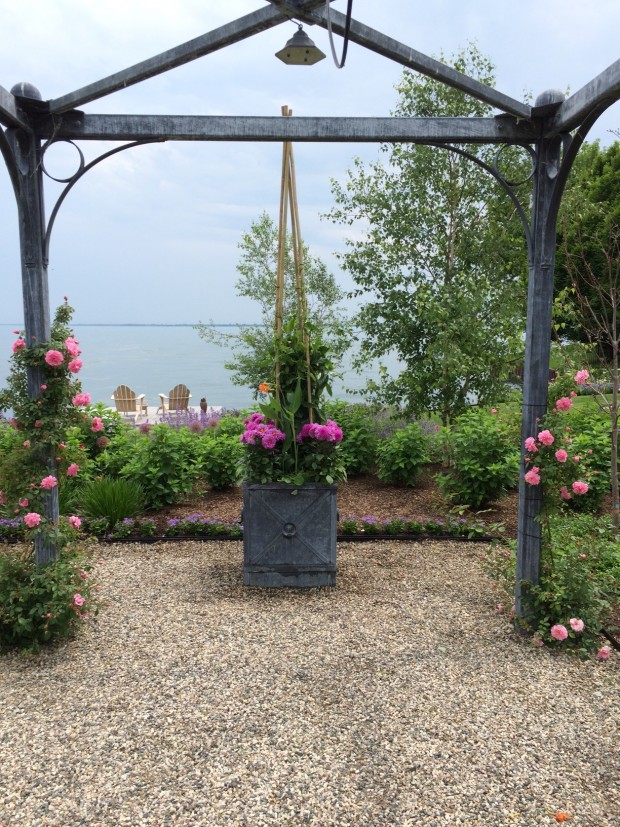 I cannot really convey with words what it meant to walk on to a property with a landscape wrought by a relationship with a very special client that seems happy in most every regard. I ws so pleased with everything I saw. My working life right now is busy-jammed packed and intense. Most days I am up at 4:30 am, and drifting home at 6pm. This seasonal planting settled me right down. Thanks, Harriet. This landscape is growing just as you would want it to. I am sure I heard that growing going on.
I cannot really convey with words what it meant to walk on to a property with a landscape wrought by a relationship with a very special client that seems happy in most every regard. I ws so pleased with everything I saw. My working life right now is busy-jammed packed and intense. Most days I am up at 4:30 am, and drifting home at 6pm. This seasonal planting settled me right down. Thanks, Harriet. This landscape is growing just as you would want it to. I am sure I heard that growing going on.
Deborah Silver is a landscape and garden designer whose firm, Deborah Silver and Co Inc, opened its doors in 1986. She opened Detroit Garden Works, a retail store devoted to fine and unusual garden ornament and specialty plants, in 1996. In 2004, she opened the Branch studio, a subsidiary of the landscape company which designs and manufactures garden ornament in a variety of media. Though her formal education is in English literature and biology, she worked as a fine artist in watercolor and pastel from 1972-1983. A job in a nursery, to help support herself as an artist in the early 80’s evolved into a career in landscape and garden design. Her landscape design and installation projects combine a thorough knowledge of horticulture with an artist’s eye for design. Her three companies provide a wide range of products and services to the serious gardener. She has been writing this journal style blog since April of 2009.
Copyright © 2024 · Deborah Silver & Co. · Detroit Garden Works